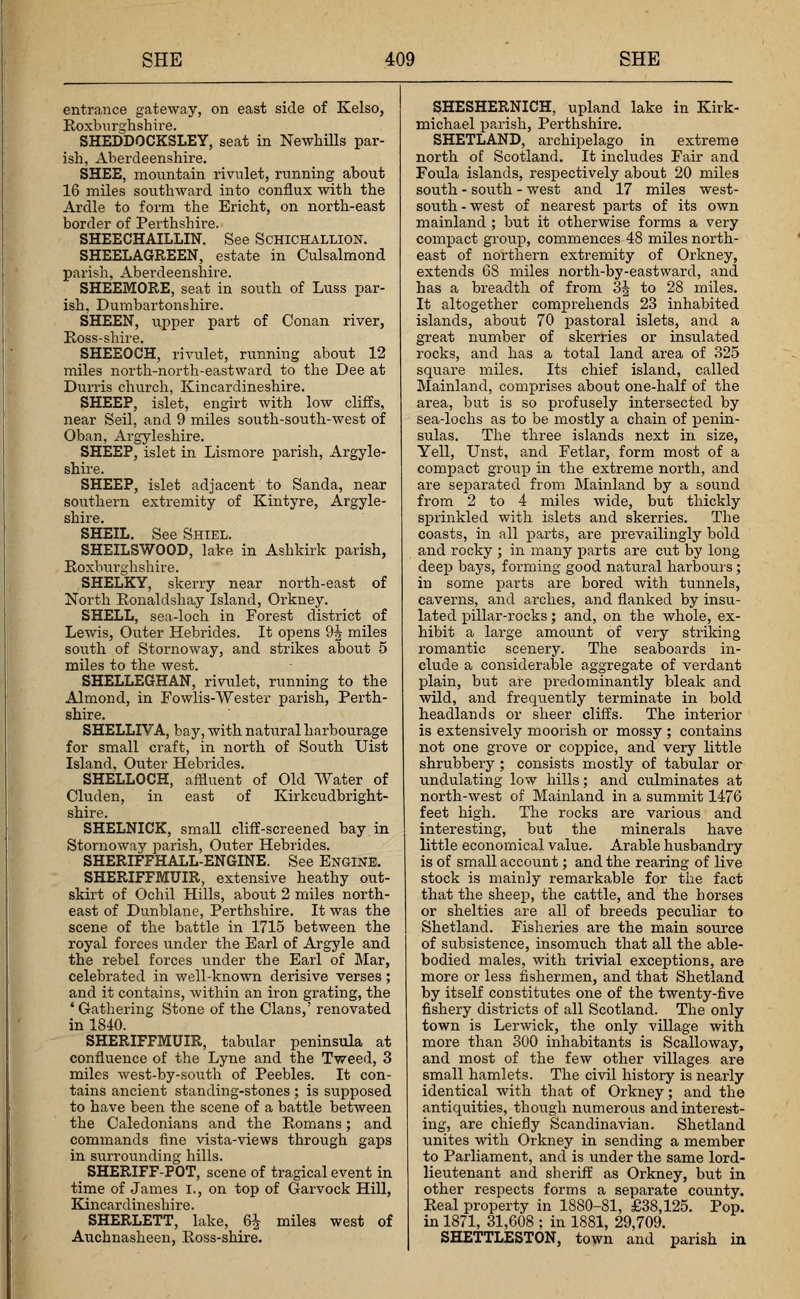SHEDDOCKSLEY, seat in Newhills parish, Aberdeenshire.
SHEE, mountain rivulet, running about 16 miles southward into conflux with the Ardle to form the Ericht, on north-east border of Perthshire.
SHEECHAILLIN.
SHEELAGREEN, estate in Culsalmond parish, Aberdeenshire.
SHEEMORE, seat in south of Luss parish, Dumbartonshire.
SHEEN, upper part of Conan river, Ross-shire.
SHEEOCH, rivulet, running about 12 miles north-north-eastward to the Dee at Durris church, Kincardineshire.
SHEEP, islet, engirt with low cliffs, near Seil, and 9 miles south-south-west of Oban, Argyleshire.
SHEEP, islet in Lismore parish, Argyleshire.
SHEEP, islet adjacent to Sanda, near southern extremity of Kintyre, Argyleshire.
SHEIL.
SHEILSWOOD, lake in Ashkirk parish, Roxburghshire.
SHELKY, skerry near north-east of North Ronaldshay Island, Orkney.
SHELL, sea-loch in Forest district of Lewis, Outer Hebrides. It opens 9 miles south of Stornoway, and strikes about 5 miles to the west.
SHELLEGHAN, rivulet, running to the Almond, in Fowlis-Wester parish, Perthshire.
SHELLIVA, bay, with natural harbourage for small craft, in north of South Uist Island, Outer Hebrides.
SHELLOCH, affluent of Old "Water of Cluden, in east of Kirkcudbrightshire.
SHELNICK, small cliff-screened bay in Stornoway parish, Outer Hebrides.
SHERIFFHALL-ENGINE.
SHERIFFMUIR, extensive heathy out-skirt of Ochil Hills, about 2 miles north-east of Dunblane, Perthshire. It was the scene of the battle in 1715 between the royal forces under the Earl of Argyle and the rebel forces under the Earl of Mar, celebrated in well-known derisive verses ; and it contains, within an iron grating, the ' Gathering Stone of the Clans,' renovated in 1840.
SHERIFFMUIR, tabular peninsula at confluence of the Lyne and the Tweed, 3 miles west-by-south of Peebles. It contains ancient standing-stones ; is supposed to have been the scene of a battle between the Caledonians and the Romans ; and commands fine vista-views through gaps in surrounding hills.
SHERIFF-POT, scene of tragical event in time of James I., on top of Garvock Hill, Kincardineshire.
SHERLETT, lake, 6^ miles west of Auchnasheen, Ross-shire.
SHESHERNICH, upland lake in Kirkmichael parish, Perthshire.
SHETLAND, archipelago in extreme north of Scotland. It includes Fair and Foula islands, respectively about 20 miles south-south-west and 17 miles west-south-west of nearest parts of its own mainland ; but it otherwise forms a very compact group, commences 48 miles north-east of northern extremity of Orkney, extends 68 miles north-by-eastward, and has a breadth of from 3 to 28 miles. It altogether comprehends 23 inhabited islands, about 70 pastoral islets, and a great number of skerries or insulated rocks, and has a total land area of 325 square miles. Its chief island, called Mainland, comprises about one-half of the area, but is so profusely intersected by sea-lochs as to be mostly a chain of peninsulas. The three islands next in size, Yell, Unst, and Fetlar, form most of a compact group in the extreme north, and are separated from Mainland by a sound from 2 to 4 miles wide, but thickly sprinkled with islets and skerries. The coasts, in all parts, are prevailingly bold and rocky ; in many parts are cut by long deep bays, forming good natural harbours ; in some parts are bored with tunnels, caverns, and arches, and flanked by insulated pillar-rocks ; and, on the whole, exhibit a large amount of very striking romantic scenery. The seaboards include a considerable aggregate of verdant plain, but are predominantly bleak and wild, and frequently terminate in bold headlands or sheer cliffs. The interior is extensively moorish or mossy ; contains not one grove or coppice, and very little shrubbery ; consists mostly of tabular or undulating low hills; and culminates at north-west of Mainland in a summit 1476 feet high. The rocks are various and interesting, but the minerals have little economical value. Arable husbandry is of small account ; and the rearing of live stock is mainly remarkable for the fact that the sheep, the cattle, and the horses or shelties are all of breeds peculiar to Shetland. Fisheries are the main source of subsistence, insomuch that all the able-bodied males, with trivial exceptions, are more or less fishermen, and that Shetland by itself constitutes one of the twenty-five fishery districts of all Scotland. The only town is Lerwick, the only village with more than 300 inhabitants is Scalloway, and most of the few other villages are small hamlets. The civil history is nearly identical with that of Orkney ; and the antiquities, though numerous and interesting, are chiefly Scandinavian. Shetland unites with Orkney in sending a member to Parliament, and is under the same lord-lieutenant and sheriff as Orkney, but in other respects forms a separate county. Real property in 1880-81, 38,125. Pop. in 1871, 31,608 ; in 1881, 29,709.
SHETTLESTON, town and parish in lower ward of Lanarkshire. The town stands nominally 3 miles south-east of Glasgow, is inhabited chiefly by operatives and colliers, and has a post office under Glasgow, a railway station, Established, Free, and Roman Catholic churches, and a large public school. Pop. with Eastmuir and Sandyholes, 3608. The parish contains also most of Millerston and Hogganfield, was constituted quoad sacra by civil authority in 1847, and ranks now as quoad omnia. Its territory is the south-eastern part of Barony of Glasgow. Real property with that of Springburn and MaryhiU in 1880-81, 151,416. Pop. of Shettleston alone, 9232. There are 7 schools for 1354 scholars, and 2 of them and an enlargement for 650 are new.

